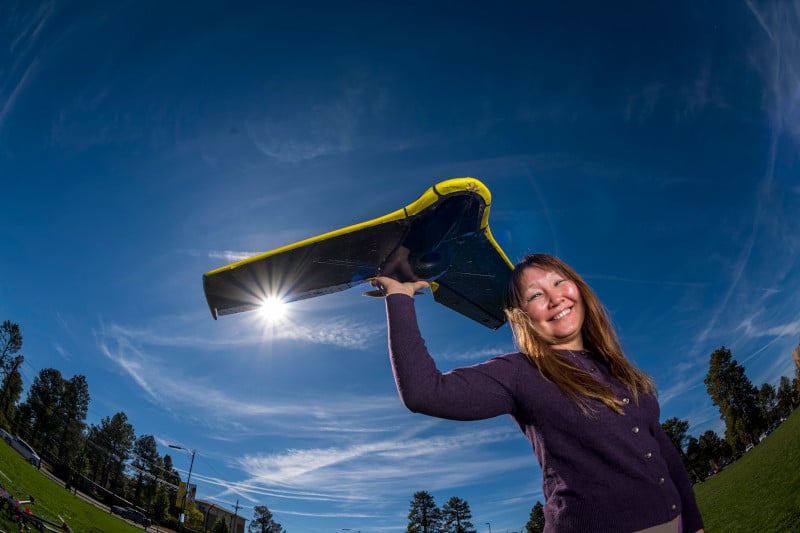As part of a five-year research agreement, the Phoenix-based Salt River Project (SRP) is funding several Northern Arizona University projects in 2020-2021 that look into forest health and restoration, renewable energy sources and increasing diversity in STEM fields. These projects build on several studies SRP was already funding.
This five-year partnership, which funds research focusing on applied research activities related to SRP’s core businesses of power and water, is allowing researchers, including student researchers, to look for solutions to specific questions facing the region.
“This partnership between NAU and SRP provides applied research advances that link the expertise and the training capabilities of the university with the practical problems facing Arizona’s communities,” said Ben Ruddell, director of the School of Informatics, Computing, and Cyber Systems (SICCS). “In particular, this year’s investment by SRP leverages NAU’s strengths in forest and watershed science, along with alternative energy, power systems, and development of a diverse workforce. This kind of public-serving partnership is what the public university mission is all about: solving practical problems through science and innovation, building competitiveness, and developing Arizona’s advanced workforce.”
“This research partnership with NAU has proven to be invaluable as students and faculty work with our technical staff to find solutions to real-world problems that could benefit SRP and our customers,” said Alejandra Mendez, a senior research engineer at SRP.
Mendez also sees this as an opportunity for SRP to work with students who could one day be part of the utility’s workforce.
“This allows us to work with students while providing them with insight into the real-life issues they could one day be working to solve,” she said.
The total amount funded for the 2020-2021 year, which is in its fourth year, is $446,125. SRP funded four new projects:
Temuulen “Teki” Sankey, associate professor in the School of Informatics, Computing, and Cyber Systems, is in the second year of an SRP-funded project that uses sensors and NAU’s supercomputer, Monsoon, to measure moisture in the soil as a function of forest thinning and other forest restoration practices. Sankey’s hypothesis is thinned, relatively open forest stands will be more resilient to drought. Two doctoral students, Adam Belmonte and Ryan Lima, are participating in the research. This research is a continuation from previous years.
David Huffman, director of research and development in the Ecological Restoration Institute (ERI) and Andrew Sánchez Meador, a School of Forestry professor and executive director of ERI, are testing the effectiveness of mobile laser screening (MLS) in southwestern forests to test MLS capabilities for quantifying historical reference conditions within an established ecological restoration study. One graduate student and two undergraduate students will participate in the research.
Tom Acker, a professor of mechanical engineering, and co-PIs Carson Pete, an ME lecturer and Fethiye Ozis, senior lecturer in environmental engineering, are collaborating to develop a lab science course that focuses on the basics of energy in society with a focus on enrolling underrepresented minorities in the class and including content specifically geared to attract these groups to the energy industry. This is following up on a 2019-20 SRP-funded project that measured the reasons why women and people of color are less likely to major in STEM programs or go into those industries. This project is ongoing.
Sánchez Meador and co-PIs Jonathon Donager, a postdoctoral scholar in ERI, and Huffman are testing the accuracy and cost assessment using a variety of types of lidar (laser scanning) systems as well as traditional field-based sample designs to assess the loading of coarse woody debris, which is an important component of forest ecosystems. One grad student and two to three undergraduate students will participate in this research.
The SRP also funded three projects in 2019-2020, along with additional funding for Acker’s and Sankey’s projects:
Acker led an off-grid desalination study on the Navajo Nation, where many residents do not have access to water and electricity services and have to pay to haul water. The researchers looked at wind and solar resources at five wells, creating an algorithm for the least costly off-grid energy system that will fund desalination and distribution.
Huffman and Sánchez Meador, along with graduate student Matt Jaquette, are studying the factors that determine historical differences in mixed-conifer forests in northern Arizona. They analyzed tree rings and field data collected from sites on the Mogollon Rim, and Jaquette developed a model that identified key drivers of historical forest variation, which can improve restoration treatments in Arizona’s forests.
Master’s student Kristiyan Milev supervised a number of electrical engineering students in identifying and evaluating possible energy storage technologies to deploy on the SRP distribution system, which has above-average usage fluctuation given the intense Phoenix summers. Finding effective, inexpensive ways to store electrical energy in low-demand times will help increase the reliable delivery of electricity during the high-load days. Acker and professor Venkata Yaramasu mentored the students.
Heidi Toth | NAU Communications
(928) 523-8737 | heidi.toth@nau.edu




